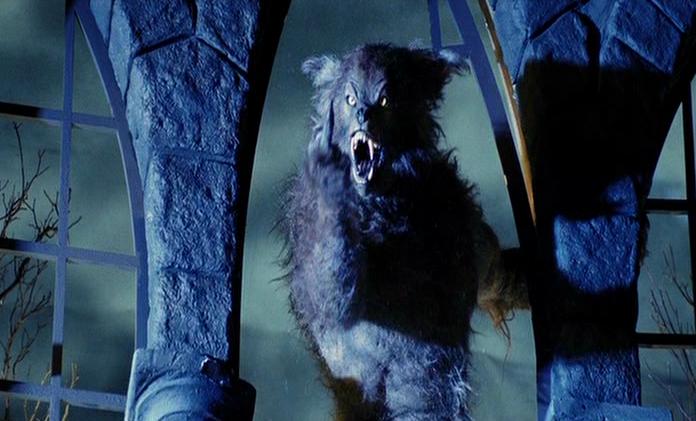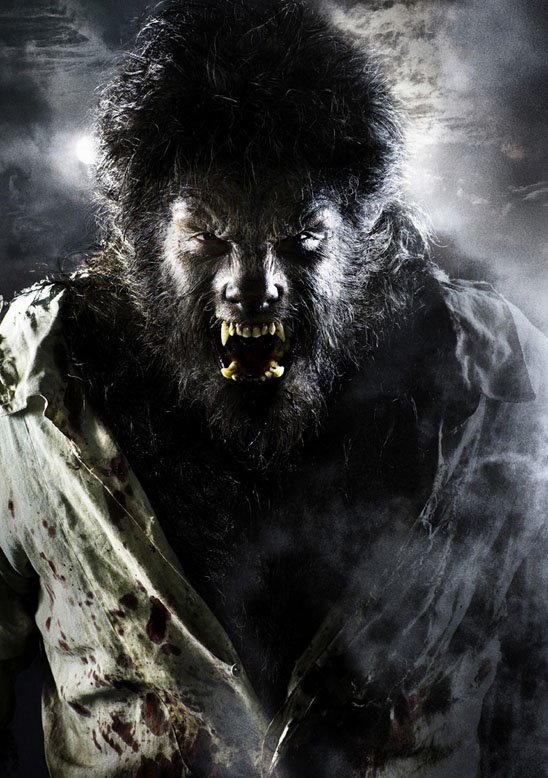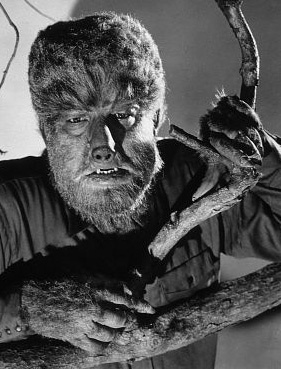 Lon Chaney, Jr.’s Wolf Man may be cinema’s most famous lycanthrope, but there can be little doubt that this 1960 film from Hammer Productions is the best werewolf movie ever made. It features all of the studio’s classic virtues: beautiful sets, effective music, colorful photography, solid scripting, memorable performances, and a muscular directorial approach that relishes depicting horror for the maximum emotional impact. The film plays out like a deliberate piece of Theatre of Cruelty, in which most of the sympathetic characters come to a tragic end. The result is actually not terribly frightening, but it is undeniably effective, in a depressing sort of way.
Lon Chaney, Jr.’s Wolf Man may be cinema’s most famous lycanthrope, but there can be little doubt that this 1960 film from Hammer Productions is the best werewolf movie ever made. It features all of the studio’s classic virtues: beautiful sets, effective music, colorful photography, solid scripting, memorable performances, and a muscular directorial approach that relishes depicting horror for the maximum emotional impact. The film plays out like a deliberate piece of Theatre of Cruelty, in which most of the sympathetic characters come to a tragic end. The result is actually not terribly frightening, but it is undeniably effective, in a depressing sort of way.
Loosely based on Guy Endore’s grim but effective novel The Werewolf of Paris, the screenplay by John Elder (a pseudonym for producer Anthony Hinds) strives to live up to the filmic title CURSE OF THE WEREWOLF by depicting a tragic saga that shows how Leon (Oliver Reed) came to be cursed with lycanthropy. Two hundred years ago, a beggar (Richard Wordsworth) runs afoul of an evil Marques (Anthony Dawson), who has him thrown into a dungeon, where he spends the ensuing years degenerating to a bestial condition. He is attended by the jailer’s daughter, who gets thrown into the cell with him after rejecting sexual advances by the Marques. The mute woman is raped by the beggar, who dies from the exertion; after killing the Marques in revenge, the woman later dies giving birth on Christmas Day to Leon, who is adopted by Don Alfredo Corledo (Clifford Evans). When Leon is a young boy, his village is terrorized by a wolf that kills several goats. The local priest explains to Don Alfredo that the unfortunate circumstances of Leon’s birth have allowed an elemental wolf spirit to take possession of his body; only love and affection can keep the evil inside him at bay. Leon grows to adulthood unaware of his true nature, but, lured to a brothel by a well-meaning friend, Leon finds his bestial side awakened, resulting in several deaths. The pure love of his fiancé is enough to stop his transformation, but when he is arrested for murder, he is separated from her and inevitably changes into a wolf again and breaks free from his cell. As angry villagers pursue him with torches, Don Alfredo reluctantly takes the only action possible, putting Leon out of his misery with a silver bullet.
It was always tempting to read Freudian interpretations into the werewolf mythology (the sudden bodily changes certainly suggest a bizarre form of puberty and sexual awakening), but little in Universal Pictures’ old black-and-white werewolf films such as THE WERE-WOLF OF LONDON (1935) and THE WOLFMAN (1941) dealt with sex on any kind of overt level. Hammer’s take on the lycanthropy legend corrects this oversight. The John Elder screenplay for CURSE OF THE WEREOLF retains the basic structure of Werewolf of Paris, which was almost lurid in its sadistic sexual detail. Fusing the established filmic conventions with Endore’s tale, CURSE manages to be the best ever cinematic treatment of lycanthropy by placing the simple transformation scenario within a larger Christian cosmology. Oliver Reed’s Leon is fated to become a monster not because of a bite but because of a defect of birth, which has allowed a predatory, demonic spirit to enter his body. This canine elemental is strongest during the full moon, but more important, it is strengthened by whatever weakens the human soul (such as lust and depravity) while held at bay by such ennobling emotions as love.
This schism between Good and Evil, between sex and love, lends a weird sexual kink to the proceedings, rendering the film as a bizarre adult fairy tale. Especially disturbing are the scene of Leon as boy describing his awakening blood-lust (he naively recounts trying to kiss a dead squirrel back to life, only to be aroused by the sweet taste of its blood) and, later, the scene of a more adult version of that lust being reawakened in a brothel (Leon returns a prostitute’s kiss with a bite to the shoulder, drawing blood, like a more bestial version of a vampire). The film is also noteworthy for making “lycanthopy=puberty” metaphor explicit: Leon first transforms into a werewolf as a boy, seen howling at the moon with new hair growing on his body.
The narrative is impressive in its attempts to show Leon’s saga from pre-conception to death, but it is not quite as perfected in terms of dramatic structure as earlier Hammer efforts like CURSE OF FRANKENSTEIN and HORROR OF DRACULA. The film is cleverly built around scenes that compare and contrast with each other, offering visual depictions of the thematic oppositions underlying the story (the brothel sequence, which triggers Leon’s transformation, is followed by a scene in which he awakes with his head chastely in the lap of his innocent fiancé, having spent the night without changing). This structure helps illustrate the ideas at work in the film, but it also slows down the pace: Leon doesn’t reach adulthood until halfway through the film; his first attack on a human doesn’t occur until 60 minutes in; and the werewolf makeup is only full revealed in the very last sequence. Clearly, audiences seeking non-stop werewolf action should seek elsewhere.
Fortunately, the film maintains interest because director Terence Fisher serves it up with his usual gusto, marshaling all of the resources at his disposal (sets, script, performances) to create a self-contained, imaginary world wherein the story makes perfect sense. In its simple Good-Evil dichotomy, CURSE OF THE WEREWOLF plays out like an adult fairy tale, and Fisher seizes on the opportunities to portray both virtue and vice. He imbues the horror with almost a touch of surrealism, underlined by the unbelievably bright orange color of the blood, while emphasizing the suffering of the innocent victims. The result is rich in symbolic implications that fire the imagination (some critics have even noted a Christ parallel in Leon who is not only born on Christmas Day but also immediately held up in front of a painting of the Madonna and Child). And in typical Fisher fashion, the gaudy trappings delight the eye with their beauty, providing an effective visual contrast with the sin and degradation that takes place on screen.
 Oliver Reed is perfect as Leon. His dark good looks evoke sympathy, yet at the same time easily convey the lurking danger within. He really makes only one misstep in the film: when forced to show his teeth to a skeptical mayor (Leon wants to convince him he’s a werewolf, but the full moon has not risen yet), he makes an awkward grimace that invites titters. Most of the rest of the cast performs splendidly as well, particularly Evans as Leon’s sympathetic stepfather. Anthony Dawson is excellent in his brief appearance as the vile Marques (at one point seen picking a carbuncle from his face). Only Catherine Feller, as Leon’s true love, fails to register as strongly as one would wish; she is sincere enough, but she cannot quite satisfy the film’s impossibly high demands of believably embodying an unbelievably perfect vessel of purity and love, untainted by sexual desire. (But then, who could?)
Oliver Reed is perfect as Leon. His dark good looks evoke sympathy, yet at the same time easily convey the lurking danger within. He really makes only one misstep in the film: when forced to show his teeth to a skeptical mayor (Leon wants to convince him he’s a werewolf, but the full moon has not risen yet), he makes an awkward grimace that invites titters. Most of the rest of the cast performs splendidly as well, particularly Evans as Leon’s sympathetic stepfather. Anthony Dawson is excellent in his brief appearance as the vile Marques (at one point seen picking a carbuncle from his face). Only Catherine Feller, as Leon’s true love, fails to register as strongly as one would wish; she is sincere enough, but she cannot quite satisfy the film’s impossibly high demands of believably embodying an unbelievably perfect vessel of purity and love, untainted by sexual desire. (But then, who could?)
In the final analysis, CURSE OF THE WEREWOLF is a statement on the bestial nature of man. The true villain of the piece is the evil Marques, who delights in abusing his underlings; by imprisoning the beggar, and later the mute servant girl, it is the Marques who sets in motion the string of events that will ultimately destroy Leon, along with so many others along the way. In varying degrees, many other characters succumb to some form of bestiality: the beggar whose imprisonment turns him into an animal who rapes the woman who has looked after him for years; the woman herself, whose sexual assault prompts her to impale the cruel Marques; the various drunks and prostitutes who degrade themselves by carousing and promiscuity; and of course, Leon himself, whose better nature fights a losing battle against the beast within.
Against all of this is balanced the potential for human goodness, which in this context is explicitly equated with celibacy (the handful of sympathetic survivors are a priest, Leon’s virginal fiancé, and the bachelor Don Alfredo, whose only relationship with a woman seems to be the platonic one with his faithful servant Teresa, played by Hira Talfrey). It’s not a very believable worldview; in fact, it’s quite reactionary, yet it’s perfectly suited to creating a rich and rewarding film about the eternal struggle in the human soul between kindness and cruelty, between purity and perversity. It’s the brilliant depiction of this duality that makes CURSE OF THE WEREWOLF a classic in spite of his slightly languid pace. It may not galvanize you with horror, but it will touch you with its tragedy.
The final sequence with Leon in wolf form pursued by the villagers (an excellent makeup by Roy Ashton that includes not just face and hands but also torso) seems designed to cast the monster as a persecuted victim, who literally dies like a dog, shot down by his own adoptive father, who wants to spare him the pain of potentially being burned to death by the torch-wielding mob. The scene is brutal and almost cruel in its abrupt finality; the audience is denied even the “rest in piece” ending of old werewolf movies, which showed their monsters revert to human form in death, implying that their souls were at peace. CURSE OF THE WEREWOLF offers no such salve; the only message seems to be that the innocent will suffer for the wickedness inflicted by others. As the final images fades, at last we glean a glimmer of understanding about why the opening credits played out over a close-up of the werewolf’s eyes…crying.
TRIVIA
THE CURSE OF THE WEREWOLF was born when a co-production deal for a film about the Spanish Civil War fell, after Hammer films had already built the sets. Wanting some return on their investment, they decided to take the novel The Werewolf of Paris and set it in Spain. Producer Anthony Hinds (writing as John Elder) adapted the screenplay himself, because there was no money left to hire a screenwriter. Hinds went on to write numerous other scripts, but this is easily his best work, due at least in part to the strength of the source material. Still, Hinds departed so radically for Endore’s novel, that one must give him a great deal of credit for the originality he brought to the movie.
One should also note that this film introduced Hinds penchant for writing mute characters (saving himself the trouble of writing dialogue for them). In this case it was the jailer’s daughter who gives birth to Leon; other non-speaking characters would appear in Hinds’ scripts for THE EVIL OF FRANKENSTEIN, DRACULA HAS RISEN FROM THE GRAVE, and FRANKENSTEIN AND THE MONSTER FROM HELL.
Anthony Dawson, who plays the Marques, would go on to play the assassin in DR. NO, the first James Bond film. The uncredited Desmond Llewellyn (who appears early on as one of the Marques’s servants) would go on to play Q, the man who supplied Bond with all his gadgets, starting with the second 007 film, FROM RUSSIA WITH LOVE.
Peter Sallis, who appears as the skeptical village mayor, would appear in numerous other Hammer films, before going on to provide the voice for Wallace in the Wallace and Gromit stop-motion movies.
DVD DETAILS
Although CURSE OF THE WEREWOLF was issued on VHS and laserdisc as a stand-alone title, its only Region 1 DVD release is as part of the Hammer Horror Series, a box set of eight titles, including BRIDES OF DRACULA, PHANTOM OF THE OPERA, KISS OF THE VAMPIRE, and EVIL OF FRANKENSTEIN. Some purists object to the pracitce of compressing so many films onto two double-sided discs, but the picture quality is actually quite good. Unfortunately, there are no bonus features, but the reasonable price makes the set worth obtaining; the $29.99 list price averages out to less than $3.75 per title – quite a bargain.

CURSE OF THE WEREWOLF (1961). Directed by Terence Fisher. Screenplay by John Elder (Anthony Hinds), based on The Werewolf of Paris by Guy Endore. Cast: Oliver Reed, Clifford Evans,Yvonne Romain, Catherine Feller, Anthony Dawson, Richard Wordsworth, Hira Talfrey, Justin Walters, John Gabriel, Michael Ripper, Peter Sallis, Desmond Llewellyn (uncredited)
 This sequel to UNDERWORLD rehashes much of what came before while abandoning the most interesting elements of its progenitor. There is lots of shooting, lots of fighting, lots of running around — but precious little reason is given to care about any of this. The result is flashy, loud, and almost devoid of genuine thrills — a movie that borrows from THE MATRIX and THE TERMINATOR, while adding almost nothing new.
This sequel to UNDERWORLD rehashes much of what came before while abandoning the most interesting elements of its progenitor. There is lots of shooting, lots of fighting, lots of running around — but precious little reason is given to care about any of this. The result is flashy, loud, and almost devoid of genuine thrills — a movie that borrows from THE MATRIX and THE TERMINATOR, while adding almost nothing new.








 The decision to show the Wolf Man clearly appears to have beena last minute one. There is little footage of the monster (which inevitably disappoints younger viewers), some of which is repeated. The monster scenes betray some continuity lapses (Talbot takes off his shirt during his first transformation, but he has it back on when he is seen in Wolf Man form, running through the woods), further indicating that the footage was hastily inserted without being properly thought through.
The decision to show the Wolf Man clearly appears to have beena last minute one. There is little footage of the monster (which inevitably disappoints younger viewers), some of which is repeated. The monster scenes betray some continuity lapses (Talbot takes off his shirt during his first transformation, but he has it back on when he is seen in Wolf Man form, running through the woods), further indicating that the footage was hastily inserted without being properly thought through.


 Excellent werewolf pic was “too British” to get a U.S. theatrical release
Excellent werewolf pic was “too British” to get a U.S. theatrical release
